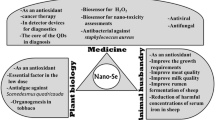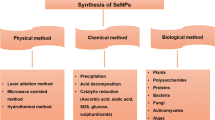Abstract
Selenium nanoparticles (SeNPs) are considered to be the new selenium supplement forms with high biological activity and low toxicity; however, the molecular mechanism by which SeNPs exert the biological function is unclear. Here, we reported that biocompatibility SeNPs possessed intrinsic oxidase-like activity. Using Na2SeO3 as a precursor and glutathione as a reductant, biocompatibility SeNPs were synthesized by the wet chemical reduction method in the presence of bovine serum albumin (BSA). The results of structure characterization revealed that synthesized SeNPs were amorphous red elementary selenium with spherical morphology, and ranged in size from 25 to 70 nm size with a narrow distribution (41.4 ± 6.7 nm). The oxidase-like activity of the as-synthesized SeNPs was tested with 3,3′,5,5′-tetramethylbenzidine (TMB) as a substrate. The results indicated that SeNPs could catalyze the oxidization of TMB by dissolved oxygen. These SeNPs showed an optimum catalytic activity at pH 4 and 30 °C, and the oxidase-like activity was higher as the concentration of SeNPs increased and the size of SeNPs decreased. The Michaelis constant (K m) values and maximal reaction velocity (V max) of the SeNPs for TMB oxidation were 0.0083 mol/L and 3.042 μmol/L min, respectively.





Similar content being viewed by others
References
Abdulah R, Miyazaki K, Nakazawa M, Koyama H (2005) Chemical forms of selenium for cancer prevention. J Trace Elem Med Biol 19:141–150
An Q, Sun C, Li D, Xu K, Guo J, Wang C (2013) Peroxidase-like activity of Fe3O4@carbon nanoparticles enhances ascorbic acid-induced oxidative stress and selective damage to PC-3 prostate cancer cells. ACS Appl Mater Interfaces 5:13248–13257
Asati A, Kaittanis C, Santra S, Perez JM (2011) pH-tunable oxidase-like activity of cerium oxide nanoparticles achieving sensitive fluorigenic detection of cancer biomarkers at neutral pH. Anal Chem 83:2547–2553
Benko I et al (2012) Subacute toxicity of nano-selenium compared to other selenium species in mice. Environ Toxicol Chem 31:2812–2820
Dutta AK, Maji SK, Srivastava DN, Mondal A, Biswas P, Paul P, Adhikary B (2012) Synthesis of FeS and FeSe nanoparticles from a single source precursor: a study of their photocatalytic activity, peroxidase-like behavior, and electrochemical sensing of H2O2. ACS Appl Mater Interfaces 4:1919–1927
Feng Y, Su J, Zhao Z, Zheng W, Wu H, Zhang Y, Chen T (2014) Differential effects of amino acid surface decoration on the anticancer efficacy of selenium nanoparticles. Dalton Trans 43:1854–1861
Feng YB, Hong L, Liu AL, Chen WD, Li GW, Chen W, Xia XH (2015) High-efficiency catalytic degradation of phenol based on the peroxidase-like activity of cupric oxide nanoparticles. Int J Environ Sci Technol 12:653–660
Forootanfar H, Adeli-Sardou M, Nikkhoo M, Mehrabani M, Amir-Heidari B, Shahverdi AR, Shakibaie M (2014) Antioxidant and cytotoxic effect of biologically synthesized selenium nanoparticles in comparison to selenium dioxide. J Trace Elem Med Biol 28:75–79
Gao L et al (2007) Intrinsic peroxidase-like activity of ferromagnetic nanoparticles. Nat Nanotechnol 2:577–583
Gao F et al (2014) Cytotoxicity and therapeutic effect of irinotecan combined with selenium nanoparticles. Biomaterials 35:8854–8866
Gao L et al (2015) Peptide-conjugated gold nanoprobe: intrinsic nanozyme-linked immunsorbant assay of integrin expression level on cell membrane. ACS Nano 9:10979–10990
Hatfield DL, Tsuji PA, Carlson BA, Gladyshev VN (2014) Selenium and selenocysteine: roles in cancer, health, and development. Trends Biochem Sci 39:112–120
Hayat A, Cunningham J, Bulbul G, Andreescu S (2015) Evaluation of the oxidase like activity of nanoceria and its application in colorimetric assays. Anal Chim Acta 885:140–147
Huang B, Zhang J, Hou J, Chen C (2003) Free radical scavenging efficiency of Nano-Se in vitro. Free Radic Biol Med 35:805–813
Hunter WJ, Manter DK (2009) Reduction of selenite to elemental red selenium by Pseudomonas sp. Strain CA5. Curr Microbiol 58:493–498
Kumar A, Sevonkaev I, Goia DV (2014) Synthesis of selenium particles with various morphologies. J Colloid Interface Sci 416:119–123
Li H, Zhang J, Wang T, Luo W, Zhou Q, Jiang G (2008) Elemental selenium particles at nano-size (Nano-Se) are more toxic to Medaka (Oryzias latipes) as a consequence of hyper-accumulation of selenium: a comparison with sodium selenite. Aquat Toxicol 89:251–256
Lin Y, Ren J, Qu X (2014) Catalytically active nanomaterials: a promising candidate for artificial enzymes. Acc Chem Res 47:1097–1105
Peng D, Zhang J, Liu Q, Taylor EW (2007) Size effect of elemental selenium nanoparticles (Nano-Se) at supranutritional levels on selenium accumulation and glutathione S-transferase activity. J Inorg Biochem 101:1457–1463
Prabhu K, Mohanraj K, Kannan S, Barathan S, Sivakumar G (2013) Effect of pH, l-arginine concentration, and aging time on selenium nanostructures. Synth React Inorg Met Org Nano Met Chem 44:383–388
Shen X, Liu W, Gao X, Lu Z, Wu X, Gao X (2015) Mechanisms of oxidase and superoxide dismutation-like activities of gold, silver, platinum, and palladium, and their alloys: a general way to the activation of molecular oxygen. J Am Chem Soc 137:15882–15891
Tao Y, Ju E, Ren J, Qu X (2015) Bifunctionalized mesoporous silica-supported gold nanoparticles: intrinsic oxidase and peroxidase catalytic activities for antibacterial applications. Adv Mater 27:1097–1104
Vekariya KK, Kaur J, Tikoo K (2012) ERα signaling imparts chemotherapeutic selectivity to selenium nanoparticles in breast cancer. Nanomed Nanotechnol Biol Med 8:1125–1132
Wang H, Zhang J, Yu H (2007) Elemental selenium at nano size possesses lower toxicity without compromising the fundamental effect on selenoenzymes: comparison with selenomethionine in mice. Free Radic Biol Med 42:1524–1533
Wang X, Sun K, Tan Y, Wu S, Zhang J (2014) Efficacy and safety of selenium nanoparticles administered intraperitoneally for the prevention of growth of cancer cells in the peritoneal cavity. Free Radic Biol Med 72:1–10
Wang Y, Chen P, Zhao G, Sun K, Li D, Wan X, Zhang J (2015) Inverse relationship between elemental selenium nanoparticle size and inhibition of cancer cell growth in vitro and in vivo. Food Chem Toxicol 85:71–77
Wei H, Wang E (2013) Nanomaterials with enzyme-like characteristics (nanozymes): next-generation artificial enzymes. Chem Soc Rev 42:6060–6093
Xu C, Lin Y, Wang J, Wu L, Wei W, Ren J, Qu X (2013) Nanoceria-triggered synergetic drug release based on CeO2-capped mesoporous silica host-guest interactions and switchable enzymatic activity and cellular effects of CeO2. Adv Healthc Mater 2:1591–1599
Yang M, Guan Y, Yang Y, Xia T, Xiong W, Wang N, Guo C (2013) Peroxidase-like activity of amino-functionalized magnetic nanoparticles and their applications in immunoassay. J Colloid Interface Sci 405:291–295
Yu S et al (2015) The inhibitory effect of selenium nanoparticles on protein glycation in vitro. Nanotechnology 26:145703–145717
Zhang J, Wang H, Bao Y, Zhang L (2004) Nano red elemental selenium has no size effect in the induction of seleno-enzymes in both cultured cells and mice. Life Sci 75:237–244
Zhang J et al (2008) Decomposing phenol by the hidden talent of ferromagnetic nanoparticles. Chemosphere 73:1524–1528
Zhang X, He S, Chen Z, Huang Y (2013) CoFe2O4 nanoparticles as oxidase mimic-mediated chemiluminescence of aqueous luminol for sulfite in white wines. J Agric Food Chem 61:840–847
Zheng W et al (2015) Multifunctional polyamidoamine-modified selenium nanoparticles dual-delivering siRNA and cisplatin to A549/DDP cells for reversal multidrug resistance. Acta Biomater 11:368–380
Acknowledgments
We thank the faculty from Analytical and Testing Center of Huazhong University of Science and Technology. This work was supported by grants from the National Natural Science Foundation of China (Project No. 31170775)and the “Youth Chen-Guang Project” of Wuhan Bureau of Science and Technology (2015070404010184).
Author information
Authors and Affiliations
Corresponding author
Rights and permissions
About this article
Cite this article
Guo, L., Huang, K. & Liu, H. Biocompatibility selenium nanoparticles with an intrinsic oxidase-like activity. J Nanopart Res 18, 74 (2016). https://doi.org/10.1007/s11051-016-3357-6
Received:
Accepted:
Published:
DOI: https://doi.org/10.1007/s11051-016-3357-6




